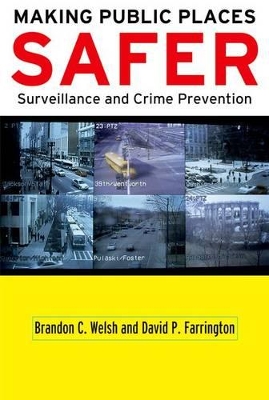Studies in Crime and Public Policy
2 total works
The United Kingdom has more than 4.2 million public closed-circuit television (CCTV) cameras--one for every fourteen citizens. Across the United States, hundreds of video surveillance systems are being installed in town centers, public transportation facilities, and schools at a cost exceeding $100 million annually. And now other Western countries have begun to experiment with CCTV to prevent crime in public places. In light of this expansion and the associated public expenditure, as well as pressing concerns about privacy rights, there is an acute need for an evidence-based approach to inform policy and practice.
Drawing on the highest-quality research, criminologists Brandon C. Welsh and David P. Farrington assess the effectiveness and social costs of not only CCTV, but also of other important surveillance methods to prevent crime in public space, such as improved street lighting, security guards, place managers, and defensible space. Importantly, the book goes beyond the question of "Does it work?" and examines the specific conditions and contexts under which these surveillance methods may have an effect on crime as well as the mechanisms that bring about a reduction in crime.
At a time when cities need cost-effective methods to fight crime and the public gradually awakens to the burdens of sacrificing their privacy and civil rights for security, Welsh and Farrington provide this timely and reliable guide to the most effective and non-invasive uses of surveillance to make public places safer from crime.
Drawing on the highest-quality research, criminologists Brandon C. Welsh and David P. Farrington assess the effectiveness and social costs of not only CCTV, but also of other important surveillance methods to prevent crime in public space, such as improved street lighting, security guards, place managers, and defensible space. Importantly, the book goes beyond the question of "Does it work?" and examines the specific conditions and contexts under which these surveillance methods may have an effect on crime as well as the mechanisms that bring about a reduction in crime.
At a time when cities need cost-effective methods to fight crime and the public gradually awakens to the burdens of sacrificing their privacy and civil rights for security, Welsh and Farrington provide this timely and reliable guide to the most effective and non-invasive uses of surveillance to make public places safer from crime.
Saving Children from a Life of Crime
by David P. Farrington and Brandon C. Welsh
Published 23 November 2006
After decades of rigorous study in the United States and across the Western world, a great deal is known about the early risk factors for offending. High impulsiveness, low attainment, criminal parents, parental conflict, and growing up in a deprived, high-crime neighborhood are among the most important factors. There is also a growing body of high quality scientific evidence on the effectiveness of early prevention programs designed to prevent children from embarking on a life of crime.
Drawing on the latest evidence, Saving Children from a Life of Crime is the first book to assess the early causes of offending and what works best to prevent it. Preschool intellectual enrichment, child skills training, parent management training, and home visiting programs are among the most effective early prevention programs. Criminologists David Farrington and Brandon Welsh also outline a policy strategy - early prevention - that uses this current research knowledge and brings into sharper focus what America's national crime fighting priority ought to be.
At a time when unacceptable crime levels in America, rising criminal justice costs, and a punitive crime policy have spurred a growing interest in the early prevention of delinquency, Farrington and Welsh here lay the groundwork for change with a comprehensive national prevention strategy to save children from a life of crime.
Drawing on the latest evidence, Saving Children from a Life of Crime is the first book to assess the early causes of offending and what works best to prevent it. Preschool intellectual enrichment, child skills training, parent management training, and home visiting programs are among the most effective early prevention programs. Criminologists David Farrington and Brandon Welsh also outline a policy strategy - early prevention - that uses this current research knowledge and brings into sharper focus what America's national crime fighting priority ought to be.
At a time when unacceptable crime levels in America, rising criminal justice costs, and a punitive crime policy have spurred a growing interest in the early prevention of delinquency, Farrington and Welsh here lay the groundwork for change with a comprehensive national prevention strategy to save children from a life of crime.

